If you’ve never got yourself tested for vitamin D deficiency, I highly recommend it. I did my first vitamin D test years ago and I paid for it myself (BetterYou vitamin D test) as I couldn’t get it done for free through my GP.
If you can, ask your GP for the test but if you don’t have any symptoms of deficiency or don’t fall into one of the high-risk groups, they will dismiss you very quickly. NHS don’t test for vitamin D deficiency routinely as they don’t think it’s necessary and it would cost them too much money. But I had to know my vitamin D levels, especially because low levels of vitamin D have been linked to all kind of health issues and illnesses, including reduced immune support function, bone loss, depression, hair loss, dementia and even cancer.
Unsurprisingly, my first vitamin D test showed that I was deficient. Since then, I make sure I supplement regularly (more often in winter) and once in a while I do a private blood test to make sure my vitamin D levels are where they should be.
There are quite a few companies which offer private vitamin D testing, but I like to use BetterYou vitamin D testing service because they work in collaboration with NHS and they also give you one vitamin D oral spray for free once you get your results.
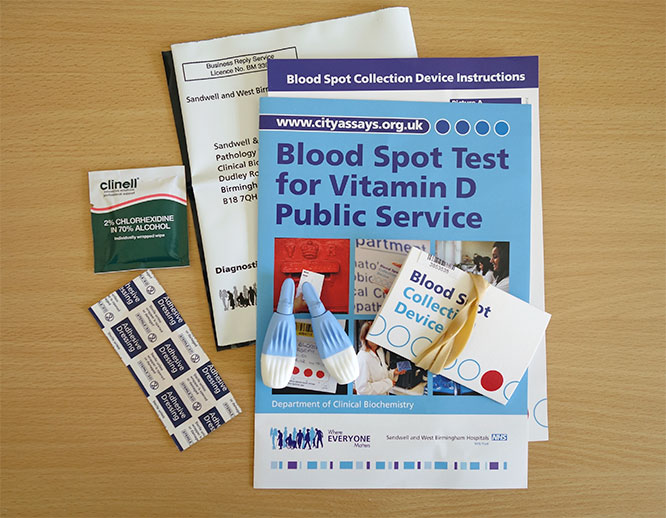
When you do the BetterYou vitamin D test at home and then send off your blood sample, this actually goes to NHS laboratories for analysis. In my opinion, it’s just reassuring to have your sample analysed by a reliable and well-trusted laboratory.
So if you are looking to get yourself tested for vitamin D deficiency at home, I highly recommend you use BetterYou. It’s actually quite simple to do the vitamin D test at home, it doesn’t take long and all you need is a few drops of blood. It may not be easy to prick your finger yourself for the first time but you can ask somebody to help you (I was actually quite nervous about doing this myself for the first time but after a few tests I got used to it).
BetterYou Vitamin D test – Step by step instructions
I had done some other types of home blood tests in the past few years and compared to those, testing for vitamin D deficiency using a BetterYou vitamin D test kit is a piece of cake. You don’t need to mess with an epruvete and you don’t need to extract much blood at all.
The procedure is easy and you get all the instructions with your test you so you really cannot get it wrong. You get two single-use lancets in the test kit, just in case one doesn’t work or you need to prick your finger again. I’ve never had to use the second lancet myself in the past but it’s a good thing it’s there, just in case.
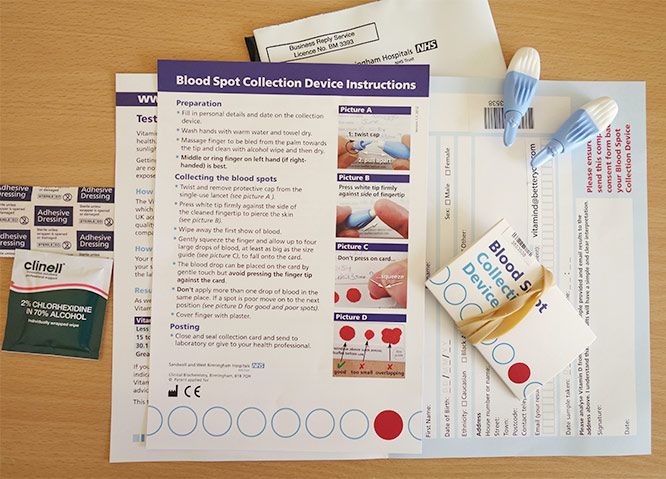
Before you start with the finger prick test, familiarise yourself with all the contents in the kit. Spread it out onto the table and carefully read all the instructions. You should know exactly what to do before the test and not read the instructions during the test when you have to act quickly and squeeze the blood out of your finger before it clots.
Before you attempt to prick your finger, fill in your personal details on the collection device (name, date of birth). Also, don’t forget to write the sample date and time. At the same time, you can also fill in a consent form where you note down the same details, but also add your physical address and email address. This is important as you get your results and recommendations back via email. Make sure you write clearly!
The next step is to wash your hands with warm water and dry them. It helps with blood circulation to massage the finger to be bled from the palm towards the tip. It’s recommended to either prick a middle or ring finger (on left hand if right-handed).
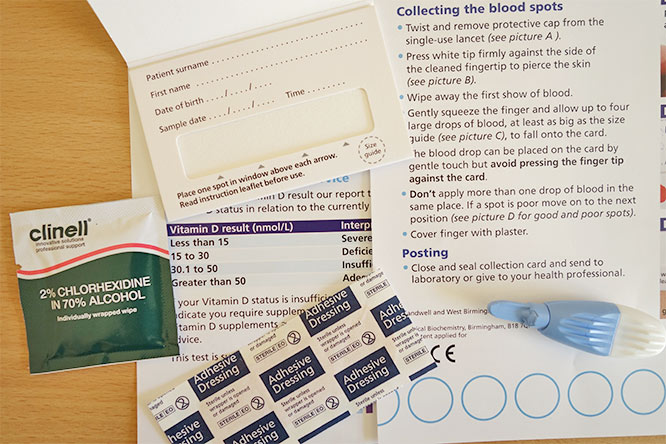
Don’t wait too long after massaging your finger! Quickly take the single-use lancet, twist it and remove the protective cap. You then firmly press the white tip against the side of the cleaned fingertip to pierce the skin. I must admit, not a pleasant moment and it may take a few attempts before you press firmly enough to cause the sharp blade to come out. It feels like a quick sting but luckily it’s over very quickly.
Once a bit of blood comes out, wipe it with a clean tissue. You then gently squeeze the finger and allow 4 large drops of blood to fall onto the card. Try to put these drops of blood in the spots where arrows are pointing to on the collection device. You should not press the fingertip against the card but you can place the blood drop on the card by gentle touch. Also worth keeping in mind, you shouldn’t place more than one drop of blood in the same place.
Once done, cover your finger with a plaster and close and seal the collection card. Put it in the provided pre-paid envelope and don’t forget to enclose the consent form. Post it on the same day, to make sure the blood sample doesn’t get spoiled when lying around. And that’s it!
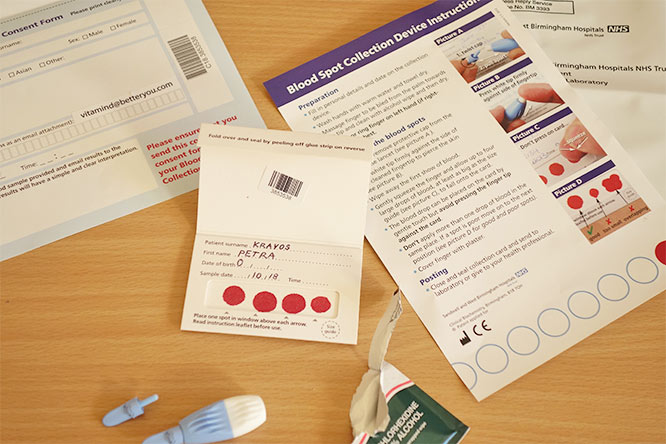
So checking your vitamin D levels at home is not too difficult, is it? I know not everybody will be comfortable with the blood side of it but it’s certainly worth doing.
Vitamin D test results
It’s surprising how fast I received my vitamin D test results. They allow for up to 10 days for you to receive the results (via email) but I received them within 3 days of posting the test. Really good! This is much faster than doing the test directly with NHS (through your GP) when blood test results could take around a week or even longer. So I guess when you do a private blood test at home, the results will be quicker since you are paying for it!
NHS laboratories measure both forms of vitamin D: Vitamin D3 and D2 giving a ‘Total Vitamin D’ level figure once you receive your results. There is also a breakdown of D3 and D2 separately but the most useful indicator is 25-hydroxyvitamin D3. As BetterYou explain:
The blood spot kits measure 25-hydroxyvitamin D, which reflects body vitamin D stores. This is generally accepted to be the most useful indicator of vitamin D status.
See the difference between vitamin D2 and vitamin D3 here.
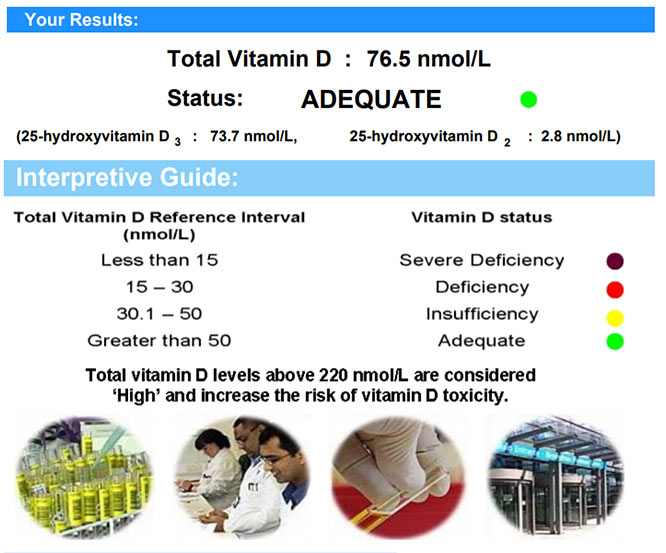
My results were actually not bad this time and they showed that my vitamin D levels were adequate. Following the email from NHS, I also received an email from BetterYou, giving me a code for a complimentary spray bottle of vitamin D and advising me on supplementation.
So the recommendation from BetterYou was as follows:
Vitamin D is extremely important, but sufficient quantities are very hard to gain through diet alone, in fact just 10 per cent of our intake is through food. The rest is generated through sun exposure. BetterYou recommends optimal levels of vitamin D are between 75-150nmol/L, which provides the body with optimum immunity support. Therefore, at 76.5nmol/L, you may wish to maintain your levels.
As a general rule, BetterYou advise that 1000IU of vitamin D is supplemented, per 25kg of body weight – as a maintenance dose. For your result, we would recommend the following supplementation guidelines of 1 spray of DLux3000 (3,000IU) per day as a maintenance dose.
The recommendation makes total sense. Of course I need to continue supplementing otherwise my levels will drop.
The price
Finally, in case you wondered how much vitamin D test costs, it’s £32.95 with a free UK delivery from BetterYou. On top of that, you also get a free bottle of BetterYou Vitamin D Oral Spray so it’s quite a good deal. I haven’t come across any other vitamin D testing providers in the UK that they do this.
So I hope that now you have a much better idea of how to do a vitamin D test at home. It’s especially worth checking your vitamin D levels if you stay away from the sun, have dark skin or you stay at home a lot (elderly, for example). Maybe you know some people who would benefit from this service and in that case, you can either tell them about this page or buy them a vitamin D test kit yourself.
Common questions people ask about vitamin D testing
Can I order BetterYou vitamin D test kit from abroad?
Yes, you can order BetterYou vitamin D test kit from abroad but you will have to pay for the return postage of your blood sample yourself. This can increase the length of time before you receive your results.
Is home vitamin D test kit suitable for children?
Yes, but they shouldn’t be younger than 6 years old. NHS advice is not to use a home-test finger prick device on younger children.
Do I have to fast before doing vitamin D test at home?
There is nothing about fasting in the instructions and whether you should take the test at a particular time of the day so it’s safely to assume that you don’t need to fast before taking this test.
How long do the results take?
BetterYou state that the results will be emailed to you within 10 working days but normally the analysis is done much faster and many times you can expect your results to arrive within 3-5 days.
How often should I test my vitamin D levels?
For personal use, it’s not recommended to test yourself more than twice a year.
Have you ever got yourself tested for vitamin D deficiency? What were your results?
